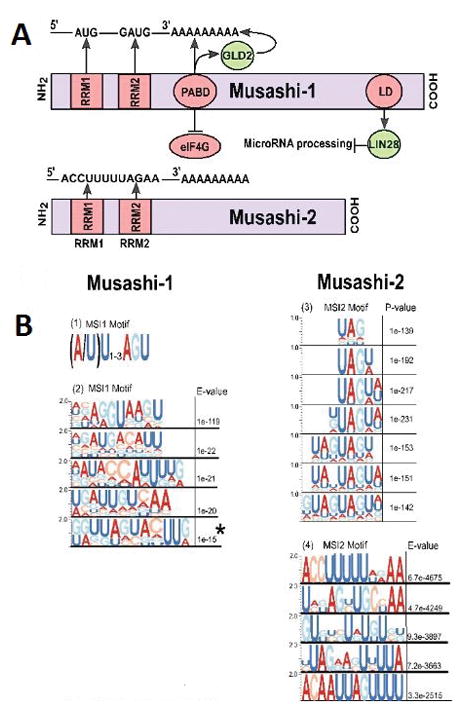Figure 2. Musashi protein interactions.

(A) Schematic representation of Musashi-1 and 2 molecular interaction domains for interactions with RNA and with RNA-binding proteins. RRM - RNA recognition motif; LD, LIN28 interaction domain; PABD - Poly-A binding domain. (B) Summary of recognition motifs identified for MSI1 in 1) Imai T et al (3), 2) Li et al (55) or MSI2 in 3) Wang S et al (37) and 4) Bennet CG et al (56). Sequence motifs are reprinted from original publications by permission of the authors and publishers. Motifs are represented in the Selex format, with size of letter reflecting preference for indicated nucleotides. (Adapted from Imai T et al. “The neural RNA-binding protein Musashi1 translationally regulates mammalian numb gene expression by interacting with its mRNA.” Mollecular and Cellular Bioliology, 2001 June; Volume 21, Issue 12. Pages 3888–900; Copyright [2001] by permission from American Society for Microbiology. Adapted from Cell Reports, Volume 13, Issue 11. Li N et al. “The Msi Family of RNA-Binding Proteins Function Redundantly as Intestinal Oncoproteins.” 2015 December 22; Pages No. 2440–55, Copyright [2015], with permission from Elsevier. Adapted by permission from Macmillan Publishers Ltd on behalf of Cancer Research UK: Nature Communications (37), copyright [2015]. Adapted from Bennett CG et al. “Genome-wide analysis of Musashi-2 targets reveals novel functions in governing epithelial cell migration.” Nucleic Acids Research. 2016 May 5; Volume 44, Issue 8, pages 3788–800, Copyright [2016] by permission of Oxford University Press.)
